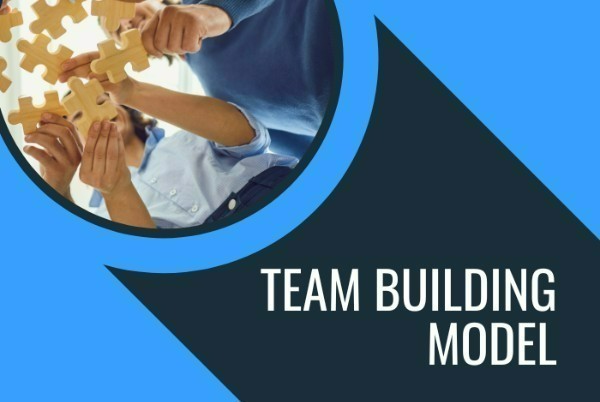Blogs
Team Building Model
Team Building Model

Team Development Stages towards High Performance
The Strength of the team is each individual member. The
strength of each member is the team. -Phil Jackson
What exactly is a Team?
A Team
comprises a group of people linked in a common purpose. Teams are
especially appropriate for conducting tasks that are high in complexity and
have many interdependent subtasks. The individuals comprising a team ideally
should have common goals, common objectives, and motives. Teams cannot be
formed if people are not compatible with each other.
“A group does not necessarily constitute a team”.
Understanding Teamwork & Team Building
Teamwork
“The process of
working collaboratively with a group of people in order to realize a goal.”
Teamwork is
the result of people effectively working together. It is vital for team members
to understand the importance of good communication skills, mutual respect, good Leadership, and excellent decision-making skills to achieve team goals. Harmonization
and collaboration of ideas and people who work towards a common objective are
called teamwork. It also helps keeping aside their personal conflicts.
Team Building
“Capability to recognize
and motivate individuals to form a team that stays together, performs together,
and accomplishes together.”
Team building
is the way to enhance team determination amongst team members for improved
relationships, productivity and openly discuss project concerns. Team building
deals with two main facets- recruiting people from the same or different teams
and engaging them in activities that can boost their career/skills and at the
same time resolve conflicts to achieve outcome.
Virtual team building activities can be planned for remote teams.
Traits of High Performing Teams
A group of goal-focused individuals with specialized expertise and complementary skills who collaborate, innovate, and produce consistently superior results. “High performing teams Understand and respect each other’s views and differences, appreciate that we all view the world through a different lens and therefore give and receive messages differently and Listen with the intent to utterly understand the other person rather than to confirm their current view or wait for the opportunity to speak.
Team
Development Stages- By Bruce Tuckman
Forming
This stage is the base of Team Development. This stage plays a vital role in deciding the future success of the team It is where team members first meet. Here, it is typical for teammates to feel excited, anxious, and curious about what lies ahead, and they look to leaders for information. Thus, it is important for Team leaders to facilitate the introductions and highlight each person’s skills and background. familiarized them with their team goals and provide them project details and the opportunity to organize their responsibilities.
Storming
At this stage, team members
will experience obstacles because they have begun working, they openly share
ideas and use this as an opportunity to stand out and be accepted by their
peers. frequent complaints, frustrations, or bottlenecks are common signs at
this stage. Team leaders help teams in this stage by having a plan in place to
manage competition, disagreements / conflicts among team members as they are
inescapable, establishing a mutual understanding between the team members and
communicate the concerns with the higher-ups to ensure projects stay track.
Norming
By this stage, teams have figured out how to work together. There is no more internal competition, and responsibilities and goals are clear. Each person works more efficiently because they have developed a mutual understanding , they are aware of each other strengths and they probably know when to extend their helping hand. he or she has learned how to share their ideas and listen to feedback while working toward a common goal. Team leaders help teams in this stage by monitoring their progress and providing them with adequate guidance.
Performing
At this stage there is a high
level of cohesion and trust between team members. Teams are functioning at peak
efficiency with less oversight from team leaders. Issues still come up, but at
this point, teams have strategies for resolving problems without compromising
timelines and progress.
Team leaders at this stage make
things easier for team by facilitating them with the required resources for the
job and keep appreciating to motivate them. It is an ideal state for any manager to
witness their team’s growth and ask reflective questions.
Adjourning
At this last stage Teams complete their project and debrief on what went well and what could be improved for future projects. This stage is all about celebrating the victory achieved together and revisiting the loopholes to avoid whenever the team takes up another task. Afterwards, team members move on to new projects. Team leaders at this stage should honor team efforts with meaningful rewards and recognition to fuel their zeal to contribute more. Also, peers can recognize and appreciate each other for their efforts.
Leadership Style at each stage of team development
|
Team Stage |
Leadership Style |
Team Member Behavior |
Leader Behavior |
|
Forming |
Directing |
Low competence High commitment |
High directive Low supportive |
|
Storming |
Coaching |
Low/Some
competence Low commitment |
High
directive High supportive |
|
Norming |
Supporting |
Moderate/High competence Variable commitment |
Low directive High supportive |
|
Performing |
Delegating |
High
competence High commitment |
Low
directive Low supportive |
Recent Blogs
Check out our others blogs
Extra $ Discount
Enroll Now to avail 20% Off on Prince2 Foundation & Practitioner Course
Copy Coupon Code: PRINCE20
